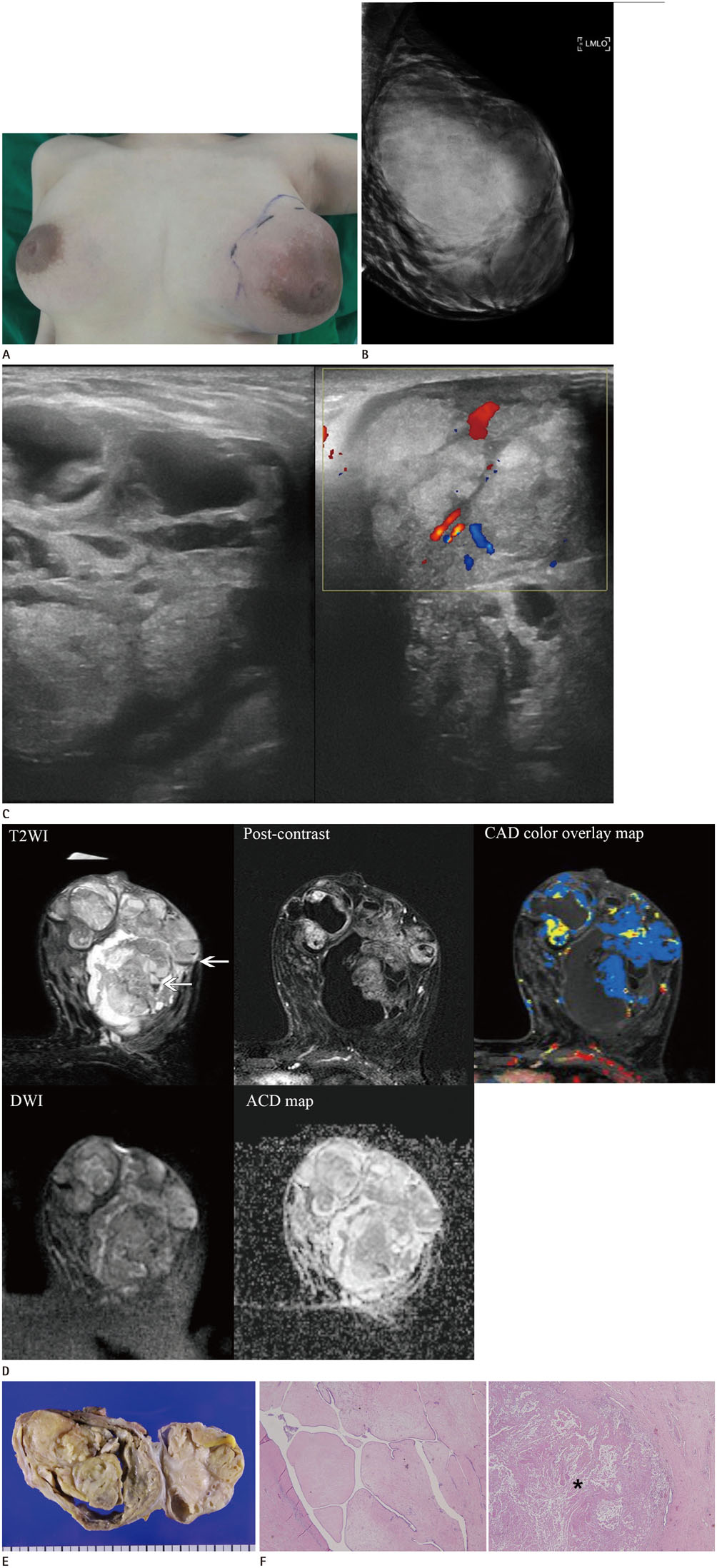J Korean Soc Radiol.
2017 Nov;77(5):327-332. 10.3348/jksr.2017.77.5.327.
Spontaneous Infarction of Phyllodes Tumor of the Breast in a Postpartum Woman: A Case Report
- Affiliations
-
- 1Department of Radiology, Wonkwang University School of Medicine, Wonkwang University Hospital, Iksan, Korea. khw@wonkwang.ac.kr
- 2Department of Pathology, Wonkwang University School of Medicine, Wonkwang University Hospital, Iksan, Korea.
- 3Department of Surgery, Wonkwang University School of Medicine, Wonkwang University Hospital, Iksan, Korea.
- KMID: 2394047
- DOI: http://doi.org/10.3348/jksr.2017.77.5.327
Abstract
- A rare tumor of the breast, phyllodes tumor is uncommon in pregnant women, and spontaneous infarction of this tumor has not been reported to date. Infarction develops in malignant tumors of the breast, but the mechanism and pathogenesis of this complication is not fully understood. Breast tumor infarction in pregnant women is uncommon, except in cases of fibroadenomas. The authors report a case of spontaneous infarction of a benign phyllodes tumor in a 30-year-old postpartum woman that exhibited rapid growth during late pregnancy; this is followed by a discussion of imaging findings.
MeSH Terms
Figure
Reference
-
1. Murthy SS, Raju KV, Nair HG. Phyllodes tumor in a lactating breast. Clin Med Insights Pathol. 2016; 9:13–17.2. Behrndt VS, Barbakoff D, Askin FB, Brem RF. Infarcted lactating adenoma presenting as a rapidly enlarging breast mass. AJR Am J Roentgenol. 1999; 173:933–935.3. Kim JY, Kim KS, Lee Y, Kim JH. Spontaneous Infarction of benign breast lesion during pregnancy: ultrasonographic and pathologic findings. J Korean Soc Radiol. 2015; 73:259–263.4. Likhitmaskul T, Asanprakit W, Charoenthammaraksa S, Lohsiriwat V, Supaporn S, Vassanasiri W, et al. Giant benign phyllodes tumor with lactating changes in pregnancy: a case report. Gland Surg. 2015; 4:339–343.5. Kim SJ. Spontaneously infarcted fibroadenoma of the breast in an adolescent girl: sonographic findings. J Med Ultrason (2001). 2014; 41:83–85.6. Jesinger RA, Lattin GE Jr, Ballard EA, Zelasko SM, Glassman LM. Vascular abnormalities of the breast: arterial and venous disorders, vascular masses, and mimic lesions with radiologic-pathologic correlation. Radiographics. 2011; 31:E117–E136.7. Oh HJ, Kim SH, Kang BJ, Lee AW, Song BJ, Kim HS, et al. Ultrasonographic features of spontaneous breast tumor infarction. Breast Cancer. 2015; 22:596–601.8. Verslegers I, Tjalma W, Van Goethem M, Colpaert C, Biltjes I, De Schepper AM, et al. Massive infarction of a recurrent phyllodes tumor of the breast: MRI-findings. JBR-BTR. 2004; 87:21–22.9. Yabuuchi H, Soeda H, Matsuo Y, Okafuji T, Eguchi T, Sakai S, et al. Phyllodes tumor of the breast: correlation between MR findings and histologic grade. Radiology. 2006; 241:702–709.10. Tan H, Zhang S, Liu H, Peng W, Li R, Gu Y, et al. Imaging findings in phyllodes tumors of the breast. Eur J Radiol. 2012; 81:e62–e69.
- Full Text Links
- Actions
-
Cited
- CITED
-
- Close
- Share
- Similar articles
-
- Myxoid Liposarcoma of the Breast Mimicking Phyllodes Tumor: A Case Report
- A case of phyllodes tumor in a 10-year-old girl
- Ductal Carcinoma In Situ Arising in a Benign Phyllodes Tumor: A Case Report
- Spontaneous Infarction of Hyperplastic Breast Tissue: A Case Report
- Invasive Cribriform Carcinoma Arising in Malignant Phyllodes Tumor of Breast: A Case Report


